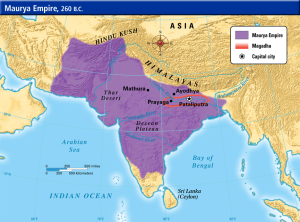Events
Classical Civilizations
From about 300 B.C.E. to about 800 C.E., Mayan civilization dominated present-day southern Mexico and parts of Central America. The Mayan civilization was made up of city-states. All the city-states were ruled by the same king. The golden age of the Mayan Civilization was from about 500 to about 850 C.E. Also, the Mayan calendar time system was very accurate for its time.
Around 321 B.C.E., a new empire arose in India. The empire extended from the Indus River Valley eastward through the Ganges River Valley and southward through the Deccan Plateau. The Mauryan Empire was founded by Chandragupta Maurya, which was wstablished by grouping Aryan kingdoms into a larger civilization. Ashoka Maurya would later be the one who would take the empire to its greatest heights, trading goods:silk, cotton, and elephants(yes, actually elephants) Mesopotamia and the eastern Roman Empire. The Mauryan Empire declined around 232 B.C.E., but was revived within the Gupta Empire (320 - 550 C.E.) that was led by Chandra Gupta. The Gupta Empire was smaller than the Mauryan, but it is often referred to as a golden age because it enjoyed relative peace and the installment of the Hindu Caste System. The Gupta Dynasty collapsed under pressure from the White Huns in 550 C.E. In China, the Han Dynasty(200 B.C.E. to around 200 C.E.) the most signifigant advancement was the invention of paper. During the time period, the societies rule was brought by the mandate of heaven (power of heaven on earth). The belief system was mainly Confucian based, with the Han establishing the civil service exam which, if passed, allowed for a high rank government position.


From 2000 B.C.E. to around 500 C.E., Greece and Rome dominated the Mediterranean. These two powerhouse civilizations initated Western civilization and trade(We love trade). The Sumerians, the Babylonians, the Egyptians, the Hebrews, the Persians, and the Phoenicians were initally in the region, but the Greeks and the Romans left the most cultural influence. One of their most important contributions is the concept of representative government, but the Greeks and Romans also made contributions to art, architecture, literature, science, and philosophy.
Late Classical Period
During the late classical period (200-600 C.E.), all the greatest civilizations that the world had known collapsed. This included the fall of Han China, the Gupta Empire in India, the western part of the Roman Empire in the Mediterranean, and the mysterious decline of the Maya.Trade routes were key in the early time period, bringing cultures, religions, and invading tribes into constant contact with each other. Major trade routes over land, like the Silk Road from China to the Roman Empire, took months to traverse.
